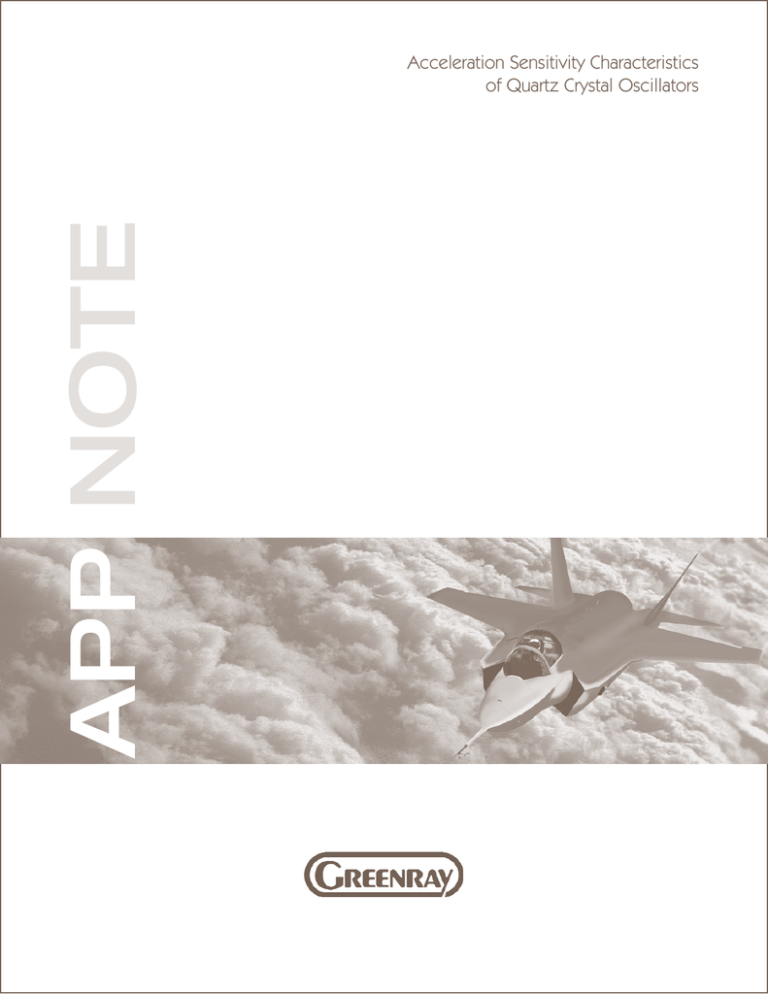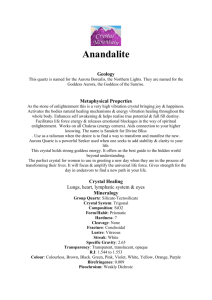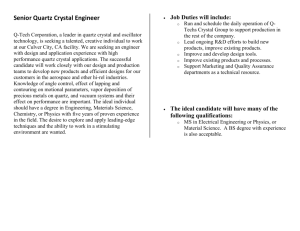
APP NOTE
Acceleration Sensitivity Characteristics
of Quartz Crystal Oscillators
T
he resonant frequency of every quartz crystal is affected by acceleration forces. The nature of the
effect depends on the type of force that is being applied. Changes in the static gravitational force being
experienced such as tilting or rotation will cause a step offset in frequency. Time dependent
acceleration or vibration will frequency modulate the output. A shock pulse will cause a sharp
temporary perturbation in the output frequency.
The magnitude of these frequency shifts is determined by the quartz crystal’s acceleration or “g-sensitivity”
vector and the characteristics of the applied acceleration force. The range of typical g-sensitivities for bulkmode quartz crystals can span several orders of magnitude, from less than 1x10-10 per g for a carefully made
precision SC cut to greater than 1x10-7 per g for a low cost AT. [1]
Since the magnitude of these effects is relatively small, they go undetected in many applications with
standard oscillators such as VCXO’s and clocks.
However with precision ovenized oscillators or those that undergo severe environmental conditions, the
inherent acceleration sensitivity can be very significant. If the oscillator is deployed in a high vibration environment such as an airborne platform, increased phase noise can degrade the system performance more than
all other sources of noise combined. But even in a benign environment, a high stability OCXO may experience significant frequency shifts. With knowledge of the operating environment that an oscillator will
experience and an understanding of the acceleration sensitivity of the quartz crystal, it is possible to predict
and plan for the expected frequency errors.
■ Description of Quartz Resonator G-sensitivity Vector
A crystal oscillator’s g-sensitivity is usually characterized by measuring the attributes along three mutually
perpendicular axes. However, the intrinsic acceleration characteristic of quartz consists of a single vector at
some angle which is usually not normal to any of the faces of the package. (See Figure 1)
By measuring the individual mutually orthogonal
components in the x, y and z axes, it is possible to
determine the magnitude and orientation of the gsensitivity vector, max.
Using the following trigonometric identities,
the characteristics of max may be calculated.
max = (gx2 + gy2 + gz2 )1/2
(1)
= (gx2 + gy2 )1/2
(2)
= arcos ( gx / gxy )
(3)
gxy
= arcSin ( gz / max )
(4)
Figure 1
1
O
nce the magnitude and angular orientation of max are known, the expected effect of externally
applied acceleration forces in any direction may be determined. When the direction of the
applied force is parallel to the axis of max it will have the greatest influence on the crystal
frequency. As the angle of the applied force moves away from the axis parallel to max, the resultant effect rolls off as the cosine of the angle Alpha. A circle is therefore defined as shown in Figure 2. Or, if
viewed in all three dimensions, a sphere with max along its axis would be described. Therefore, the resultant g-sensitivity of the crystal in any direction as a function of and is given by:
g (, ) = max x cos x cos
(5)
■ Orientation to Achieve “Zero” G-sensitivity
When the force is applied in the opposite direction, a frequency shift of equal magnitude but opposite sign
is produced, defining the second circle shown in Figure 2. Because of the vector and cosine nature of the gsensitivity vector a plane of zero g-sensitivity is present as defined by the plane that is normal to max.
This illustrates the fact that any force applied to the crystal which is perpendicular to max will have a
minimal effect on the frequency. (See Figure 2)
■ G-sensitivity Measurement Methods
Relative Acceleration Sensitivity vs.
Relatively small frequency shifts must be
Angle of Force Vector
measured when characterizing a crystal
oscillator’s g-sensitivity. One way of
Area of Negative
165 170 175 180-175 -170-165
160
-160
Frequency
making basic measurements on a
155
-155
150
-150
Deviation
145
0.8
-145
precision oscillator is to use changes
140
-140
135
-135
in the earth’s gravitational field to
130
-130
0.6
125
cause shifts in the oscillator frequency.
-125
This technique is known as the “2-g
Tipover” method. The frequency
change is measured as the unit is
turned upside down. The net effect is
a change of 2g. Therefore, the amount
of frequency shift measured divided
by 2 is the oscillator’s g-sensitivity in
that axis. The procedure is then
repeated for the other two axes.
Although conceptually simple, this
method requires a stable oscillator
to be able to consistently measure
the small frequency shifts that occur.
120
115
110
105
-120
-115
-110
-105
0.4
0.2
100
95
90
85
80
75
70
65
60
55
50
45
-100
-95
-90
-85
max
40
35
30
Area of
25
20 15
Positive Frequency
10
Deviation
5 0 -5 -10 -15
-20
-80
-75
-70
-65
-60
-55
-50
-45
-40
-35
-30
-25
Plane of Zero
g-Sensitivity
Figure 2
In order to obtain a precision dynamic measurement, the performance of the crystal is measured while
vibration is applied. The level of the induced sidebands may be determined using the standard FM
modulation index formula:
Sideband Level (dB) = 20 log ( f / 2fm )
2
(6)
G
iven that fm equals the vibration frequency fv and g is the peak applied vibration level, f is given
by:
f = g x x fnom
(7)
The formula may be rewritten as:
Vib Sidebands (dB) = 20 log ((g x x fnom) / 2fv)
(8)
Using a narrowband spectrum analyzer with high dynamic range, it may be possible to measure these sidebands directly. If necessary, the modulation index and the sideband levels may be increased by multiplying
the frequency of the crystal. This will result in an increase of sideband level of 20(logN) where N is the
multiplication factor. It may be necessary, however, to increase the resolution of the measurement even
further. This may be accomplished by phase locking another oscilla tor to the Unit Under Test to suppress
the carrier signal. The standard test set-up for measuring vibration induced effects is shown in Figure 3.
This configuration implements a sensitive low noise phase locked loop frequency discriminator.
While sinusoidal vibration generates
discrete sidebands at the vibration
frequency, the effects of random
vibration cause a general rise in the
noise floor.
Phase Locked Loop Frequency Discriminator
Vibration
Controller
Accelerometer
By knowing the power spectral density
of the vibration input, it is possible to
compute the g-sensitivity of the crystal
from the resultant phase noise plot.
Baseband
Spectrum
Analyzer
UUT
Vibration
Table
Low Noise
Amp
The sideband formula given above is
modified to use the PSD of the vibration
input giving:
Reference
Oscillator
Figure 3
Loop
Filter
EFC
£(f) = 20 log (((2xPSD)1/2 x x fnom) /
2fvr)
(9)
Figure 4 shows the phase noise of a low noise 100MHz OCXO at rest and also with random vibration
applied. This illustrates that even moderate levels of random vibration can degrade the phase noise
performance of an oscillator by 40 or 50dB.
100 MHz OCXO Random Vibration Z - AXIS
-60
-70
Random Vibration Profile
-80
1
-90
0.1
-100
-110
0.01
-120
-130
0.001
1
-140
3
10
100
1000
Vibration Frequency (Hz)
10000
-150
-160
Figure 4
-170
-180
10
100
1K
L(f) [ dBc/Hz ] vs f [ Hz ]
10K
100K
■ Typical g-Sensitivity Performance
Actual measurements of groups of crystals show that even with careful design, a large spread in the
magnitude of the g-sensitivity vector as well as it’s direction is typically present. Figure 5 shows the data
from a group of 100MHz 5th overtone SC cut crystals in TO-05 holders. These crystals were all from a single
group manufactured under supposedly identical conditions, but significant differences are still evident
within the group.
Applications which require the lowest acceleration sensitivity will usually require SC cut crystals. The SC has
been shown to have an average max that is 2 to 4 times better than a similar AT cut at the same frequency.
G-Sensitivity of 100MHz 5th Overtone SC-Cut Crystals
SN
5
9
29
21
23
10
7
39
33
11
26
28
12
27
20
24
60
48
45
55
61
gx
1.38E-10
1.95E-10
3.89E-10
7.08E-10
4.79E-10
4.73E-10
2.48E-10
2.32E-10
6.31E-10
3.59E-10
1.64E-10
3.16E-10
3.13E-10
5.19E-10
4.79E-10
4.12E-10
3.06E-10
2.95E-10
5.02E-10
1.72E-10
3.55E-10
max
gy
gz
2.84E-10
1.01E-10
2.27E-10
58.6
5.89E-10
2.82E-10
4.79E-10
67.8
7.22E-10
3.43E-10
5.02E-10
52.2
1.07E-9
2.14E-10
7.68E-10
47.3
8.27E-10
2.89E-10
6.10E-10
51.9
6.78E-10
1.76E-10
4.52E-10
43.7
5.30E-10
4.68E-10
1.30E-11
3.0
6.29E-10
5.19E-10
2.69E-10
49.3
1.27E-9
3.68E-10
1.04E-9
58.6
8.78E-10
3.24E-10
7.33E-10
63.9
7.79E-10
5.13E-10
5.63E-10
73.7
8.47E-10
5.19E-10
5.89E-10
61.8
7.55E-10
2.89E-10
6.24E-10
63.4
9.00E-10
3.76E-10
6.31E-10
50.6
1.08E-9
2.35E-10
9.34E-10
62.8
5.95E-10
1.48E-10
4.03E-10
44.3
5.71E-10
2.85E-10
3.89E-10
51.9
4.86E-10
1.02E-10
3.72E-10
51.5
7.39E-10
5.31E-10
1.14E-10
12.8
3.22E-10
2.66E-10
5.96E-11
19.1
5.21E-10
3.35E-10
1.82E-10
27.2
Avg. = 7.17E-10
Stdev = 2.4E-10
20.9
28.6
28.4
11.6
20.4
15.0
62.0
55.6
16.9
21.6
41.2
37.8
22.5
24.7
12.6
14.4
30.0
12.2
45.9
55.7
40.0
Figure 5
■ Conclusions
Although it is not possible to completely eliminate the effects of acceleration on the frequency of a quartz
crystal oscillator, by understanding the vector nature of the crystal’s g-sensitivity characteristic, the impact in
most applications can be minimized and managed acceptably.
References
[1] J.R. Vig, “Quartz Crystal Resonators and Oscillators – A Tutorial,” June 1999
[2] R.L. Filler, “The Acceleration Sensitivity of Quartz Crystal Oscillators: A
Review,” IEEE Transactions on Ultrasonics, Ferroelectrics and Frequency
Control VOL. 35, No. 3, May 1988, pp.297-305
Author: Steve Fry, Greenray Industries, Inc.
4
App Note 01.2006 © 2006 Greenray Industries, Inc. All rights reserved.
All specifications subject to change without notice.
Precision quartz-based oscillators for the wireless, wired telephony, aerospace, military, satellite, and other communications markets.
Greenray Industries, Inc.
840 West Church Road, Mechanicsburg, PA 17055
Telephone: 717-766-0223 Fax: 717-790-9509
www.greenrayindustries.com e-mail: sales@greenrayindustries.com




